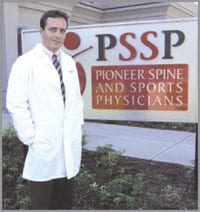A Going Concern High-tech Therapy Brings Relief To Patients With Bladder Problems
It’s a health issue that doesn’t get mentioned often, but having a bladder control problem can have serious implications for those who suffer from it.
Fortunately, a therapy developed in the past decade has helped numerous patients who suffer from this debilitating problem. Interstim therapy is a way for patients to manage urinary retention and symptoms of overactive bladder when other treatments have failed. The system uses a mild nerve signal to stimulate the sacral nerves that influence the behavior of the bladder, sphincter, and pelvic floor muscles.
Several types of patients can benefit from this therapy, according to Dr. Stanley Swierzewski III, who heads Hampden Urological Associates at 10 Hospital Drive on the Holyoke Medical Center campus.
“It can help patients who have urine retention of a non-obstructive nature, as well as those with intistitial cystitis, which is a inflammatory condition of the bladder that causes pain whenever the bladder moves,” Swierzewski said. “These patients often have urgency frequency and urge incontinence.”
Urgency frequency is an uncontrollable urge to urinate, but results in very small amounts of urine being passed. Urge incontinence is uncontrolled urine loss accompanied by a strong, sudden desire to void. Clearly, both these problems can wreak havoc with not only a person’s social life, but also the ability to hold a job or engage in any prolonged activity without a bathroom nearby.
By using Interstim therapy, patients can seize the reins of the nerves controlling these sudden and/or frequent urges.
“It’s literally like flipping a switch,” Swierzewski said.
“The procedure is a simple one,” he added, “involving very small incisions and done under intravenous sedation. The devices used are entirely hidden beneath the skin, allowing patients to continue a normal lifestyle. It doesn’t do anything that will ever harm the nerves, and the procedure can even be done without using general anesthesia.”
The therapy involves connecting a neurostimulator, which is fitted to sit in a small pocket made from the fatty tissue in the upper buttock region, to a wire positioned near the sacral nerve. The settings are then adjusted in subsequent visits to the doctor to allow for the most effective control of the bladder.
The procedure is simple, yet the effects are both physically and emotionally astounding.
One patient who suffered for years with both urgency frequency and urge incontinence problems is Jose Perez of Springfield. Perez said that Swierzewski gave him his life back through the therapy.
“It saved my life, and Dr. Stan changed my life,” Perez said. “I couldn’t go anywhere unless I knew where a bathroom was. I just couldn’t do anything.”
Perez had tried many other therapies to no avail. Along with the urgency-frequency problem, he also found that he would urinate uncontrollably while sleeping.
“I was depressed. Some days I’d feel like I’d need to urinate 100 times, but now I go when I want to go,” he said. “It’s been a miracle. I recommend it to anyone who has this kind of problem. Don’t wait. Go see the doctor.”





Comments are closed.